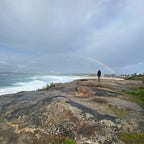building curiousity — things I didn’t know until I started studying
The important thing is not to stop questioning. Curiosity has its own reason for existence. One cannot help but be in awe when he contemplates the mysteries of eternity, of life, of the marvelous structure of reality. It is enough if one tries merely to comprehend a little of this mystery each day. — Albert Einstein
As Einstein says, “curiousity has its own reason for existence”. Well for me (until recently), curiousity was centered around the task at hand. The thought pattern would go something like this: I want to learn how to make a clay cup ➡ wonder what clay I need ➡ ️what’s the differences between different clay types ➡ how long does it need to dry ➡ what techniques are there ➡ OH this Japanese technique is interesting ➡ WOW clay products have existed for 1000’s of years. And so it goes, I started with a task and find myself pulled in by the power of curiousity.
However, since starting my Masters, I am beginning to cultivate a new kind of curiousity. The curiousity that just exists, regardless of a task being there. For example, I have a conversation with someone about neuroplasticity, and instead of listening and walking away with the thought “that was an interesting conversation”, I go home and read about it. I question it and engage with it.
This thinking is what has helped me also cultivate more meaningful relationships and more engaging conversation topics that are beyond my areas of expertise or passion. So, I wanted to share three things that I became curious about this past semester:
- The good ol’ carbon footprint. I know it’s been quite popular in the media over the past few years but my curiousity begain after taking a subject called input-output (IO) analysis where I actually learnt a method that you can use to calculate it yourself (plus all the assumptions that go into it). Simply put, using IO, you conduct a series of matrices operations (in Excel or MatLab) which map your spending to the emissions associated with the dollar output of each sector in the economy (1). So essentially I looked at my consumption over a year (an estimate of my spending on energy, transport, clothes, food etc), mapped it to the sectors, and the sectors associated emissions to find my footprint (since I won’t be explaining the way to do this in this article, you can also use online tools like this to calculate your carbon footprint online). This subject got me thinking and curious about the things I consume and where I can make changes in my life to help my footprint. For example, my new surfboard of all things was responsible for 650kg of CO2! But this got me thinking, as I plan on keeping my surfboard for years to come, the emissions could be discounted over its lifetime (yet another reason to keep things or buy second hand). This also revealed things that the IO model can’t account for, aka buying something second hand presumably would have less emissions associated with it. Anyhow, if you calculate your carbon footprint and are mortified, a suggestion is to pick one area to start with and go from there! ABC’s Fight For Planet A picks three areas: energy, transport, and food and provides useful tips on how to start there.
- Trawling may be responsible for more emissions than the airline industry! (2). This one was mindblowing 🤯. I discovered this article as I was searching for a topic for one of my subjects. Again, building my curiousity mindset, I started to question, how? How: Well, CO2 that is sequestered in the seabeds and near the ocean floor is raked up by trawlers and released into the atmosphere as the water is pulled to the surface along with the catch. After learning how, I kept on going and found that: only 2.7% of the worlds oceans are highly protected in Marine Protection Areas (MPAs) (7% are protected under non-enforceable MPAs) and 1.3% of the ocean floor is trawled every year (3). Dire isn’t it? But: ocean recovery is possible in the next three decades (this Nature article talks all about it)! So I thought what can I do? Two easy things I recommend are: Buy/understand where to find sustainable seafood (or go vegetarian or vegan) or donate to campaigns that are lobbying against trawling or support ocean protection (like this 30x30 campaign to protect 30% of our land and oceans by 2030)! 🐟
- The plastic industry invented the recycling campaign ♻️. Yes, they actually did. This revealing documentary from Frontline & PBS showed that as the environmental movements started to occur in the 1960/70’s and plastic started to be dubbed as “bad”, plastic manufacturers decided to make it’s customers feel good about buying plastic. How? They started promoting recycling programs without even having established recycling facilities or processes. Ridiculous right?! Would highly recommend watching the documentary program to flex your curiousity about plastics and how recycling came to be.
So to conclude, my biggest tip, is to ask one question about anything you read or see (this article provides some other good tips too). Ok, yes, that can be overwhelming, but maybe try for one question a day on something outside your comfort level. See where it gets you and build a curious mindset!
Again, thanks for reading!
—
Other resources:
